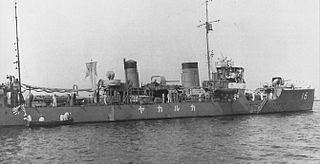This page is based on this
Wikipedia article Text is available under the
CC BY-SA 4.0 license; additional terms may apply.
Images, videos and audio are available under their respective licenses.

The Tacoma class of patrol frigates served in the United States Navy during World War II and the Korean War. Originally classified as a gunboat (PG), they were reclassified as a patrol frigate (PF) on 15 April 1943. The class is named for its lead ship, Tacoma, a Maritime Commission (MARCOM) S2-S2-AQ1 design, which in turn was named for the city of Tacoma, Washington. Twenty-one ships were transferred to the British Royal Navy, in which they were known as Colony-class frigates, and twenty-eight ships were transferred under Lend-Lease to the Soviet Navy, where they were designated as a storozhevoi korabl, during World War II. All Tacoma-class ships in US service during World War II were manned by United States Coast Guard crews. Tacoma-class ships were transferred to the United States Coast Guard and various navies post-World War II.
USS Poughkeepsie (PF-26), a Tacoma-class frigate in commission from 1944 to 1945, was the first ship of the United States Navy to be named for Poughkeepsie, New York. She later served in the Soviet Navy as EK-27 and in the Japan Maritime Self-Defense Force as JDS Momi (PF-4), JDS Momi (PF-284) and as YAC-13.

Momi was a Matsu-class destroyer of the Imperial Japanese Navy, sunk on 5 January 1945 by an American air attack west of Manila, in the South China Sea.

The Minekaze class was a class of fifteen 1st-class destroyers of the Imperial Japanese Navy. Obsolete by the beginning of the Pacific War, the Minekaze-class ships were relegated to mostly secondary roles, serving throughout the war as patrol vessels, high speed transports, target control vessels, and as kaiten carriers. Most ultimately were lost to U.S. and British submarines. The basic design of the Minekaze was used for the next three classes of Japanese destroyers, a total of 36 ships.

Akikaze was a Minekaze-class destroyer, built for the Imperial Japanese Navy immediately following the end of World War I. The Minekaze class of destroyers were considered advanced for their time; these ships served as first-line destroyers through the 1930s. The class was considered obsolete by the start of the Pacific War and served in a number of roles including minesweeper, aircraft rescue ships and Kaiten-carriers.
Several ships have been named Matsu :
Several naval ships of Japan have been named Sakura :

The Wakatake-class destroyers were a class of eight 2nd-class destroyers of the Imperial Japanese Navy.

The Japanese destroyer Karukaya (刈萱) was a Wakatake-class destroyer of the Imperial Japanese Navy. One of a class of eight 2nd-class destroyers, the ship was built by the Fujinagata Shipyard in Osaka, Japan. She was laid down on 16 May 1922, launched 19 March 1923, and commissioned 20 August 1923 as Dai-18-Go Kuchikukan, the name being changed to Karukaya on 1 August 1928.
The No. 1-class patrol boat was a class of patrol boats of the Imperial Japanese Navy (IJN), serving during World War II. 2 vessels were converted from Minekaze-class destroyers in 1940.

The No. 31-class patrol boats were a class of patrol boats of the Imperial Japanese Navy (IJN), serving during World War II. 9 vessels were converted from Momi-class destroyers and 1 vessel was converted from a Wakatake-class destroyer in 1940.
Several ships have been named Kaya :
Several ships have been named Kusunoki or Kusu :
Several ships have been named Nire :

The Japanese destroyer Kaya (榧) was one of 21 Momi-class destroyers built for the Imperial Japanese Navy (IJN) in the late 1910s. She was decommissioned in 1939 and subsequently scrapped.

The Japanese destroyer Nire (楡) was one of 21 Momi-class destroyers built for the Imperial Japanese Navy (IJN) in the late 1910s. She survived the Pacific War and was subsequently scrapped by mid-1948.

The Japanese destroyer Kiku (菊) was one of 21 Momi-class destroyers built for the Imperial Japanese Navy (IJN) in the late 1910s. She was converted into a patrol boat in 1940 and spent the Pacific War on escort duties, mostly in Japanese waters. The ship was sunk by American carrier aircraft in early 1944.
Two ships of the Imperial Japanese Navy were named Fuji:










